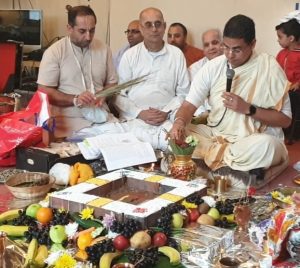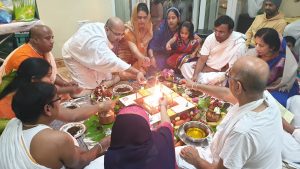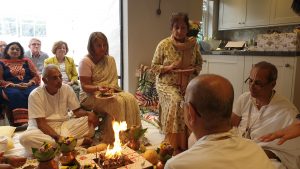
Iskcon Coventry - Hare Krishna Temple
Hare Krishna Hare Krishna, Krishna Krishna Hare Hare | Hare Rama Hare Rama Rama Rama Hare Hare ||
The temple Brahmins are well versed and trained in performing specialised yagya ceremonies for new homes, birthday celebrations and other occasions as well as perform samskara ceremonies on the birth of a new child and other events throughout its life.

Many devotees are beginning to realise the necessity of, and practical functions of the system of Samskaras as laid down in the Culture of Krishna consciousness.His Divine Grace, Srila A.C.Bhaktivedanta Swami Prabhupada was very keen to see that this culture, of genuine appreciation of God, Krishna culture, be again established for all persons irrespective of material social status (Varna or Ashram), colour or creed. We recognise that as spirit souls with material bodies, we need to redirect our attention toward Him, our constitutional position at all of the conditional / maturational / developmental stages of life. We as members of the International Society for Krishna Consciousness are trying to fulfil those wishes by making available pujas in your home, or at our local temple, with the view to helping us all redirect ourselves closer towards Krsna, the Supreme Personality of Godhead.
“I want to take this opportunity to fully endorse the providing of SAMSKARA SERVICES for the congregation as a means of helping them advance in Krishna consciousness as well as making them feel a part of the Krishna consciousness family. It makes the temple relevant to their lives when temple authorised brahmanas perform the samskaras. It creates a community spirit as the samskara event also becomes a social event inviting families and friends to come and witness the specific ceremony and accept a feast, etc. Every temple should strive to provide these kind of Krishna conscious samskaras. HH Bhakti Vidya Purna Swami Maharaja, based in Mayapur, has published an English translation of Gopal Bhatt Goswamis (of the 6 Goswamis) Sat-kriya Samskara Dipika which contains all the principle samskars. It always impressed me that if one of the 6 Goswamis took the trouble of writing these samskaras then it is obvious that we should utilise them.”
 Explanation of Garbhadhanam (Impregnation) – Rite for invoking a pious child into the womb of the mother
Explanation of Garbhadhanam (Impregnation) – Rite for invoking a pious child into the womb of the mother
Sosyanti Homa (Rite for safe delivery of the child) – performed a few days before the birth of the child
Niskramanam (Taking the child out for the first time) – performed 10th, 12th, 15th 30th day following birth dependant upon varna
Nama Karana (Name giving ceremony) – performed on the first, tenth, twelfth, hundredth day or one full year from birth. It is explained in the Satapatha-bramana, that one’s name act as a shield against evil. A good combination of sounds, when forming a name in harmony with the person receiving it, has a most important effect.
 Paustika Karma (Ceremony for the continued health of the child) – performed once every month for the childs first year
Paustika Karma (Ceremony for the continued health of the child) – performed once every month for the childs first year
Anna Prasana (First grains ceremony) – 6th or 8th month for boy and 5th and 7th month for girls
During this ceremony, the priest asks Lord Vaisvanara (Vishnu) to enter the child’s body to accept the solid foods he will eat throughout his/her life. This ceremony marks the beginning of a certain detachment from the mother by the child.
Sri Krishna says in the Bhagavad-Gita (15.14) I am the fire of digestion in the bodies of all living entities, and I join with the air of life, outgoing and incoming, to digest the four kind of foodstuff. Along with Anna-prasana the Child’s Tendencies is also performed. Parents can verify their child’s tendencies by placing before him different objects right after anna-prasada. What he chooses will reveal his calling. Unless the supreme lord helps the child in digestion, there is no possibility of eating. He thus produces and digest foodstuff, and by His grace we are enjoying life.
Cuda Karanam (Hair-cutting ceremony) – performed during the males first year between the childs 1st and 2nd year is the best option, 3rd year 2nd option and 5th year 3rd. It is custom among pilgrims in India to offer one’s hair to the Deity. This is a sign of detachment for mankind greatly values this bodily ornament. This is also an offering unto nature in return for her gifts in the form of foodstuff and well-being.
Putra Murdhabhighranam (Smelling the sons head) – performed after Anna Prasana
Grha-pravesa This ritual is performed so that the new place (House, Shop etc.) will be purified, and Vishnu can reside at that place and stay there to make their place protected and blessed. This is done also to scare away the negative subtle entities and burn the bad karma associated with the place.
The above ceremonies require the performance of yajna with the exception of Niskramanam, putra murdhabhighranam, and Garbhadhanam
Samskara services which require yajna will be £108 plus donation for the Brahmin/Priest.
Full prasadam feast can be arranged and cooked by the devotees at the temple and will be charged at extra cost.
The Samskaras that do not require yajna will be £51 donation for the ceremony.